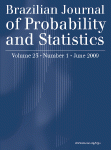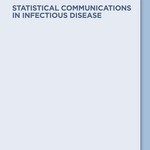 Extensions of the ogive skew normal item response model
Extensions of the ogive skew normal item response modelWe introduce new applications of the skew-probit IRT model by considering a flexible skew-normal distribution for the latent variables and by extending this model to include an additional random effect for modeling dependence between items within the same testlet. A Bayesian hierarchical structure is presented using a double data augmentation approach. This can be easily implemented in WinBUGS or SAS by considering MCMC algorithms. Several Bayesian model selection criteria, such as DIC, EAIC and EBIC, have been considered; in addition, we use posterior sum of squares of the latent residuals as a global discrepancy measure to model comparison. Two applications illustrate the methodology, one data set related to a mathematical test and another related to reading comprehension, both applied to Peruvian students. Results indicate better performance of the more flexible models proposed in this paper.
Año de publicación: 2013
 Bayesian skew-probit regression for binary response data
Bayesian skew-probit regression for binary response dataSince many authors have emphasized the need of asymmetric link functions to fit binary regression models, we propose in this work two new skew-probit link functions for the binary response variables. These link functions will be named power probit and reciprocal power probit due to the relation between them including the probit link as a special case. Also, the probit regressions are special cases of the models considered in this work. A Bayesian inference approach using MCMC is developed for real data suggesting that the link functions proposed here are more appropriate than other link functions used in the literature. In addition, simulation study show that the use of probit model will lead to biased estimate of the regression coefficient.
Año de publicación: 2013
 A New Robust Regression Model for Proportions
A New Robust Regression Model for ProportionsA new regression model for proportions is presented by considering the Beta rectangular distribution proposed by Hahn (2008). This new model includes the Beta regression model introduced by Ferrari and Cribari-Neto (2004) and the variable dispersion Beta regression model introduced by Smithson and Verkuilen (2006) as particular cases. Like Branscum, Johnson, and Thurmond (2007), a Bayesian inference approach is adopted using Markov Chain Monte Carlo (MCMC) algorithms. Simulation studies on the influence of outliers by considering contaminated data under four perturbation patterns to generate outliers were carried out and confirm that the Beta rectangular regression model seems to be a new robust alternative for modeling proportion data and that the Beta regression model shows sensitivity to the estimation of regression coefficients, to the posterior distribution of all parameters and to the model comparison criteria considered. Furthermore, two applications are presented to illustrate the robustness of the Beta rectangular model.
Año de publicación: 2012
 Male circumcision and risk of HIV acquisition among MSM.
Male circumcision and risk of HIV acquisition among MSM.OBJECTIVES: To assess the association between male circumcision, insertive anal sex practices, and HIV acquisition in a cohort of MSM. METHODS: Data were from 1824 HSV-2-seropositive, HIV-seronegative MSM, 1362 (75%) from Peru and 462 (25%) from the US, who participated in a randomized placebo-controlled trial of HSV-2 suppression for HIV prevention (HPTN 039). Circumcision status was determined by examination at enrollment. HIV testing was done every 3 months for up to 18 months. Partner-specific sexual behavior for up to the last three partners during the previous 3 months was analyzed. RESULTS: There was no significant association between male circumcision and HIV acquisition in univariate analysis [relative risk (RR) = 0.84, 95% confidence interval (CI) 0.50-1.42]. In a prespecified multivariate analysis that assumed a linear relationship between the proportion of insertive acts and effect of circumcision on HIV acquisition, the interaction between circumcision and proportion of insertive acts was not significant (P = 0.11). In an exploratory analysis that categorized behavior with recent partners by proportion of insertive acts (<60 or ≥60% insertive acts), circumcision was associated with a nonstatistically significant 69% reduction in the risk of HIV acquisition (RR = 0.31, 95% CI 0.06-1.51) among men who reported at least 60% of insertive acts with recent male partners. CONCLUSION: Circumcision does not have a significant protective effect against HIV acquisition among MSM from Peru and US, although there may be reduced risk for men who are primarily insertive with their male partners. This association needs to be investigated across diverse cohorts of MSM
Año de publicación: 2011
 Nonparametric and Semiparametric Analysis of Current Status Data Subject to Outcome Misclassification.
Nonparametric and Semiparametric Analysis of Current Status Data Subject to Outcome Misclassification.In this article, we present nonparametric and semiparametric methods to analyze current status data subject to outcome misclassification. Our methods use nonparametric maximum likelihood estimation (NPMLE) to estimate the distribution function of the failure time when sensitivity and specificity are known and may vary among subgroups. A nonparametric test is proposed for the two sample hypothesis testing. In regression analysis, we apply the Cox proportional hazard model and likelihood ratio based confidence intervals for the regression coefficients are proposed. Our methods are motivated and demonstrated by data collected from an infectious disease study in Seattle, WA.
Año de publicación: 2011
